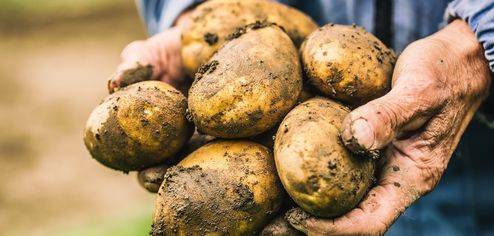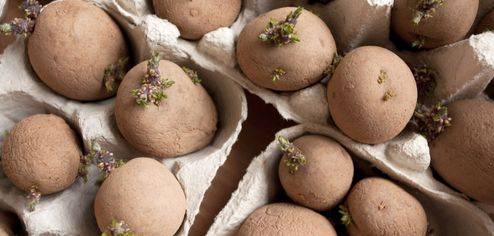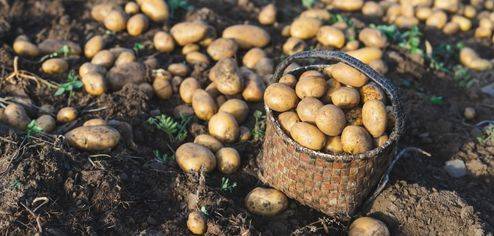Potatoes
Potatoes are hugely versatile vegetable and a staple ingredient in many meals. Potatoes are classified as being either earlies or maincrops. Early potatoes are ready to harvest much sooner than maincrops and usually called 'new potatoes'. Maincrop potatoes are in the ground a lot longer, they have a better yield and produce bigger potatoes or tubers.
EASE OF GROWING (Scale 1-5): 2

HOW TIME CONSUMING:
Potatoes do require a bit of work, seed potatoes usually require 'chitting' before planting out and the plants do need to be earthed up fairly regularly to prevent the tubers turning green.
RECOMMENDED VARIETIES:
Picasso AGM: A heavy-cropping maincrop potato with creamy skin and pink eyes, good disease resistance.
Desiree: A firm favourite with rosy skin and pale yellow flesh - a very versatile maincrop potato.
Charlotte AGM: A popular salad potato with yellow-skinned waxy tubers - treat as an early potato.
Accent AGM: A first early potato with creamy waxy flesh and good scab resistance - a tasty new potato.
HOME GROWN VS SUPERMARKET:
Although most potato varieties are cheap and readily available in supermarkets, they don't have the flavour of fresh home grown potatoes - the first new potatoes are a real treat every year!
BEST SITES AND SOILS:
Potatoes can be grown in pots and potato bags are also popular, but when growing in open ground choose an open position, in full sun on fertile and well drained soil. It is best to avoid areas where potatoes have been grown for two years in succession to reduce the risk of disease. It is best to have a slightly acidic soil, but potatoes will tolerate a wide range of soils. In alkaline conditions, applying sulphur to the top of the potato ridge after planting.
WHEN TO SOW:
It is a key with earlies and also a good idea with maincrop to chit the seed potatoes prior to planting - bascially this just means to let them start sprouting shoots. The seed potatoes can be stood up in egg boxes or similar, with the end with the most small dents in the skin or 'eyes' facing upwards. Store in a light, frost-free place until the shoots are about 3cm (1 inch long). They are then ready to be planted.

First earlies: around late March
Second earlies: early to mid-April
Maincrops: mid to late April
This can vary slightly depending on the location in the country and planting is earlier if in containers.
PLANTING AND GROWING:
The traditional way to plant the seed potatoes is to dig a narrow trench aound 12cm (5in) deep. Lining the trench with compost or grass clippings can help get a bigger crop. Space the seed potatoes 30cm (1ft) apart for earlies in rows 60cm (2ft) apart and for maincrop varieties place the tubers 37cm (15in) apart in rows 75cm (30in) apart. The early shoots are susceptible to frost damage, so try to plant in a sunny spot and avoid frost pockets.
When the stems are around 23cm (9in) high, the plants need to be earthed up, carefully drawing soil up to the stems and covering to produce a flat-topped ridge about 15cm (6in) high. This can be little and often or in one go. This is done to protect the early foliage from frost damage and protect new potatoes from turning green due to sunlight which makes the tubers poisonous.
It is important to keep the crops well watered in dry weather, especially when the tubers have started to form. It can also be beneficial to add a liquid feed of a balanced, general fertiliser every fortnight to help increase yields.
WHEN TO HARVEST:
First early potatoes should be ready to harvest in June and July, second earlies in July and August with maincrops from late August through October.

STORING POTATOES:
It is best to set the potatoes out in a dry, well ventilated position for a few hours, just to dry the skin. These can then be stored in hessian potao sacks in a dark, cool and frost free place. Don't stor potatoes in polythene bags as this causes the potatoes to sweat and can make them rot.
COMMON PROBLEMS:
Potato Blight
Symptoms: Very common in warm and wet summers, the initial symptoms are a rapidly spreading brown, watery rot which affects the leaf and stems. The potatoes can also be affected causing brown decay below the skin, which develops into a soft rot.
Remedy: When blight starts it is hard to stop. Blight-affected leaves can be removed, but this stops the plant growing as well. Earthing up the potatoes does give some protection to the tubers. A protective fungicide can be used even before signs of blight appear during June. If plants become infected they should be removed and destroyed to prevent spreading the disease.
Slugs
Symptoms: Damage to the foliage and to developing tubers can be a sign of slugs, also their silvery trails are a giveaway that there is a slug problem.
Remedy: There are a lot of ways to kill and prevent slugs from home made beer traps to slug pellets. We rely on Nemaslug in our kitchen garden, an organic, safe and effective slug control solution which uses nematodes.
Potato Scab
Symptoms: Potatoes have raised scab-like lesions on their surface. These can be easily removed by peeling and does not affect the taste of the potato.
Remedy: There is no cure, but it seems to occur more in dry conditions so be sure to keep the plants well watered. Don't store any potatoes that have scab.
Blackleg
Symptoms: Spread through contact and particularly prevalent in wet and poorly drained soils. A bacterial disease which causes blackening of the stems and causes the stems to rot and collapse. The leaves can also turn yellow or brown. When infected the tubers display brown slimy rot inside or can rot away completely.
Remedy: Blackleg generally infects single plants and does not spread or persist in the soil. Remove and destroy any infected plants, improve the soil drainage and try to use blackleg resistant varieties.

























